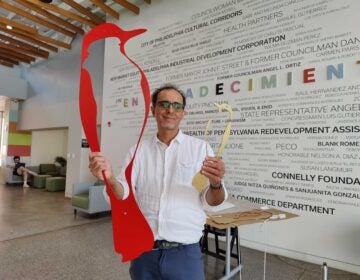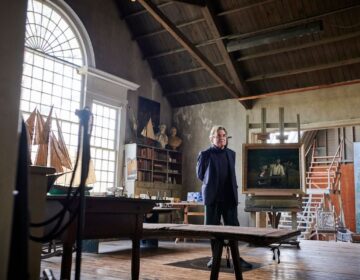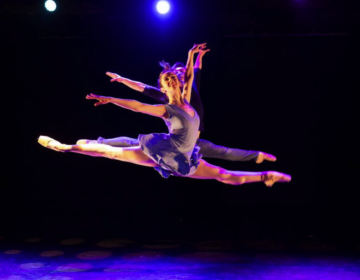Inside museum of Jewish History
The newest addition to Independence Mall is finally finished. The National Museum of American Jewish History had its coming-out party this weekend with a series of events. It will open to the public later this month. The building at Fifth and Market streets adds a touch of modern architecture to the Mall’s historic brick with a design that serves practical and symbolic needs.
From a distance, the building looks protective – like it’s wrapped in a steel mesh. But upon closer inspection visitors can see the exterior is made from sheets of glass with thousands of tiny bits of ceramic baked in. It’s called “fritted” glass, and architect James Polshek says the building juxtaposes glass, terra cotta and granite.
“In some ways it’s a minimal piece of sculpture,” said Polshek. “The story of a discourse is so fundamental to Judaism – with not a clear answer to anything. The dialogue is between opaque and translucent.”
Polshek is quick to point out that he created a spiritually neutral design that has nothing to do with Judaism directly. It’s a historical museum, not a religious one, but the secular and the reverent can’t help but overlap.
Using technology to engage emotions
The museum uses sound and video to immerse the visitor in the story of the Jewish experience in
America, beginning before the United States even existed. The first Jewish immigrants arrived in 1654.
This is an interactive display letting museumgoers stand in the shoes of a 19th century immigrant being vetted by an American customs official.
Curator Josh Perelman uses interactive technology wherever possible to present multiple perspectives of the Jewish experience.
“We didn’t want to do a top-level,esoteric thing.” said Perelman. “We wanted people to get emotionally into the story.”
The main exhibition areas are crammed with screens and displays and artifacts: in a mockup of a 1950s suburban kitchen, even the refrigerator has a tiny TV embedded inside, showing home movies of mid-century Jews. The experience is dense – and a little overwhelming.
“There are moments you are immersed in a subject, and when you come out it’s a burst of light. It allows for a moment of relaxation and decompression,” said Perelman.
Perelman is talking about that glass wall on the front of the building. As visitors exit the exhibition area, they enter a four-story atrium fed with sunlight from the fritted glass walls and a skylight. The building itself manipulates light to emotionally guide visitors through the experience.
After the crush of historical information in the exhibition, visitors can walk out on the balcony and through the veiled glass see one of the best views of Independence Mall, where American democracy was first drafted.
“Think about freedoms we enjoy in this country – they are intoxicating,” said Michael Rosenzweig, museum president. But he said freedom can be a double-edged sword.
“It’s limitless – including the freedom to abandon your traditions and heritage,” he said.
A delicate dance
Museum executives and curators had long discussions about how much Judaism to embrace in the historical exhibition, and how far the institution itself would comply with Jewish law. It got complicated.
“Were we to comply with Jewish law it would be simple – we could close on Saturdays – Shabbat – and close on all Holy Days. We needed to embrace a policy that would not comply with religious law but show attention to the tradition,” Rosenzweig said.
He and his board came up with a tricky set of rules. The museum will close on Holy Days but only the major ones – Yom Kippur, two days of Rosh Hashana, two days of Passover. It will be open on Saturdays, but no money will be exchanged: tickets for that day will have to be bought in advance or off-site. The gift shop will be open but no cash will be accepted on Saturdays – only credit cards. Those electronic transactions will be processed after sundown.
“The most important aspect is all of this will be overtly communicated with visitors'” said Rosenzweig. “We do make this a teachable moment – the mission of the museum is to educate.”
It’s all about dialogue — which visitors can join. The museum has video recording booths allowing people to add their own stories.
Click below for an insider’s peek at the museum and exhibitions. (Photography by Peter Tobia)
WHYY is your source for fact-based, in-depth journalism and information. As a nonprofit organization, we rely on financial support from readers like you. Please give today.




